After a long dark winter, it’s time to brighten up your garden with some beautiful and colorful flowers. Adding some flowers can rejuvenate your garden and attract pollinators to your vegetable garden.
But what flowers do well in spring? Let’s find out.
In this article, we shall discuss the 15 best flowers for spring, and we will also share some useful tips to help you make the most out of them.
Pansy
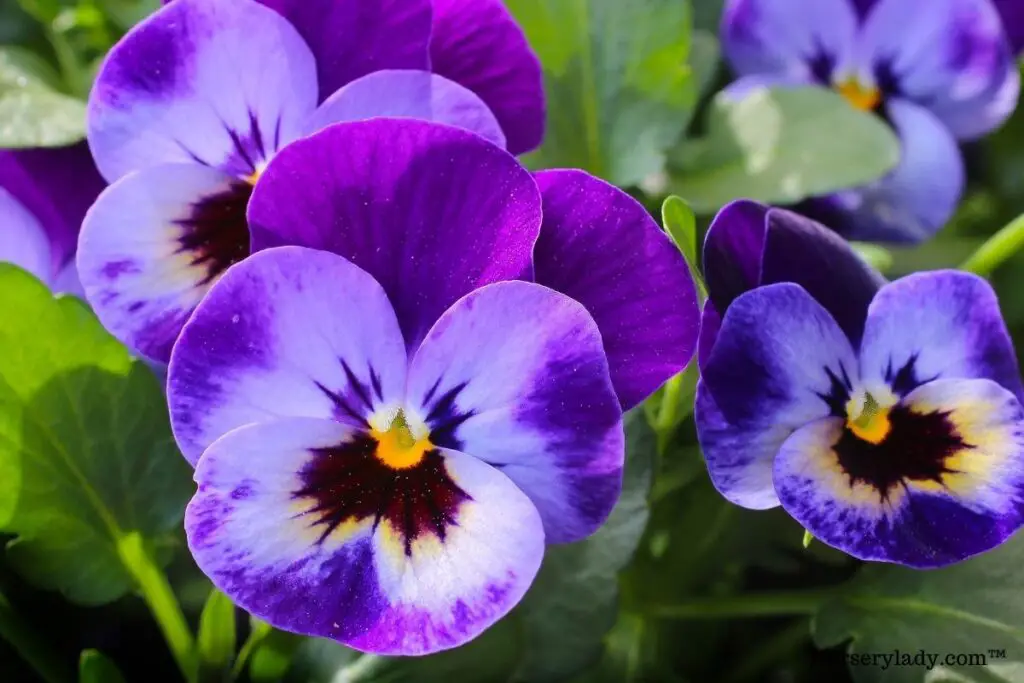
Pansy is a charming plant with flowers in a variety of shades. They are fast-growing and look stunning in baskets, hanging pots, window boxes, and in-ground cover too. They add color to your garden in early spring and fade with the summer heat.
Light: Pansy appreciates full sun but grows in partial shade too. They grow better in bright indirect light or partial shade as the direct sun can scorch their leaves and affect their growth.
Watering: Water pansy to keep its soil wet but do not overwater it. Ensure that the excess water is draining out after watering. They will not last all season, but proper watering will improve their blooming.
Fertilizer: Feed pansy with balanced flowering fertilizer monthly in the growing season. Dilute the fertilizer to avoid over-fertilizing. Too much can make them leggy and burn the roots.
General care: Pansy likes cool temperatures, and they are sensitive to heat and may decline in hot summer. During frost, please keep them in a warm area like near radiators, furnaces, fireplaces, etc. Deadhead after flowering to avoid self-seeding.
Daffodil
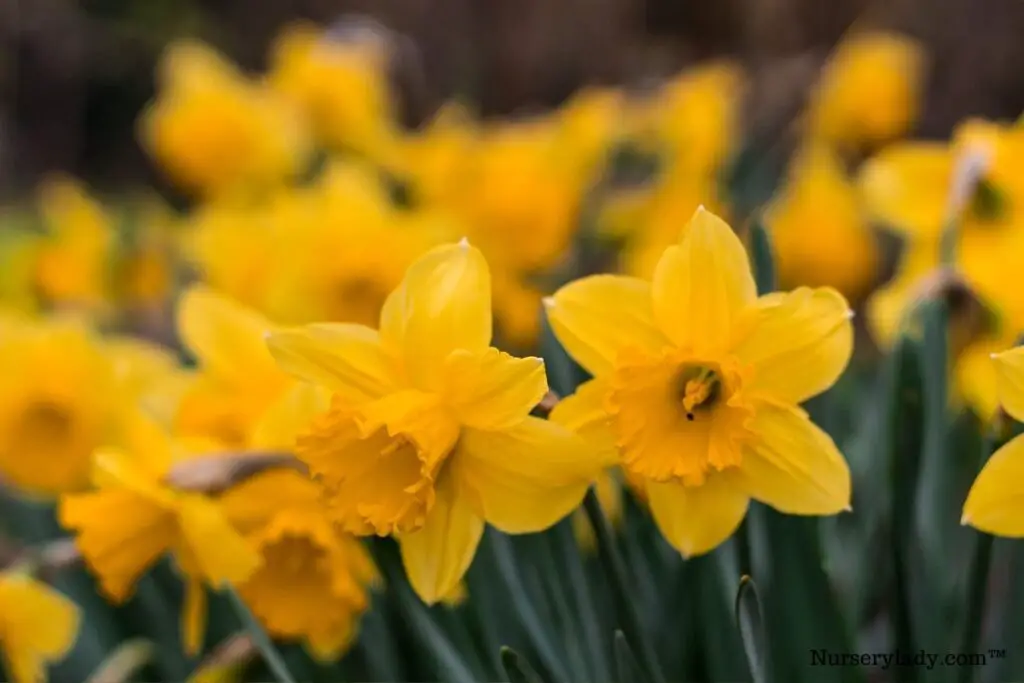
Daffodils are easy to grow spring flowers. They have sunny yellow flowers that will bloom for years if good care is taken. They come in different heights, forms, colors as there are so many species. They look beautiful in a container garden, pathways, etc.
Light: Daffodils like growing in full sun but can bear low light areas too. If there is low light, use grows lights to provide them with better light. They will not grow as bright and forward-facing in low light.
Water: Daffodils like consistent watering to stay evenly moist. They prefer dry soil during summer, stop water 3 – 4 weeks after the flower fades. This is done to take the plant out and store it until fall. Use well-draining soil and ensure a proper drainage system.
Fertilizer: Daffodils are light feeders and can thrive without feeding. We recommend feeding if the soil is poor. Feed with bulb fertilizer or bone meal during their growing period first and then when they flower.
General care: Daffodils need cool weather to set roots, and they are not picky about humidity. They are toxic to pets; keep them in a safe spot if you have pets around.
Primroses
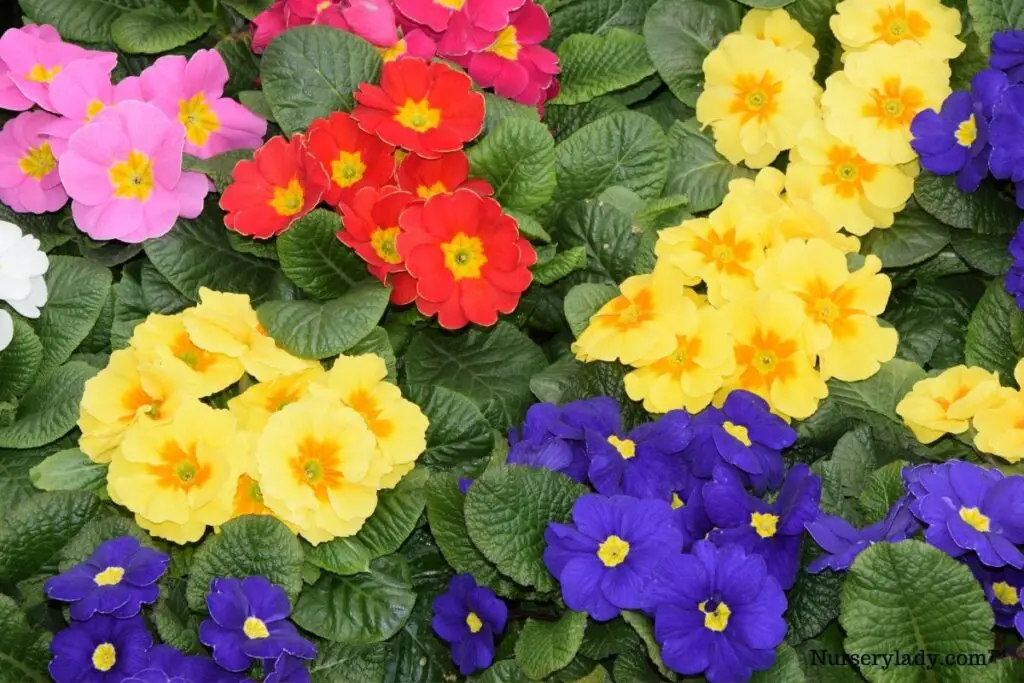
Primroses produce small blooms that brighten your garden in spring. They are hardy and add colors by growing in the ground, baskets, hanging pots, etc. They grow slowly if grown from seeds, and it is better to bring grown primroses from the nursery.
Light: Primroses prefer bright light or shaded areas. They prefer indirect light and appreciate some shade from harsh sun rays. Some varieties may do well in full sun too.
Water: Primroses asks for frequent watering but avoids drowning the soil in water. Water them to keep the soil evenly moist. The best way is by checking the soil moisture every few days to provide enough water. You can also add mulch into the soil to retain moisture.
Fertilizer: Primroses can be fed with a diluted balanced fertilizer in the growing season. They will do well with feeding once in the spring, and it is advised to avoid overfeeding.
General care: Primroses are cold hardy, and may struggle in high heat. They should be kept in a suitable location, and you will see them going through winter easily.
Lenten rose
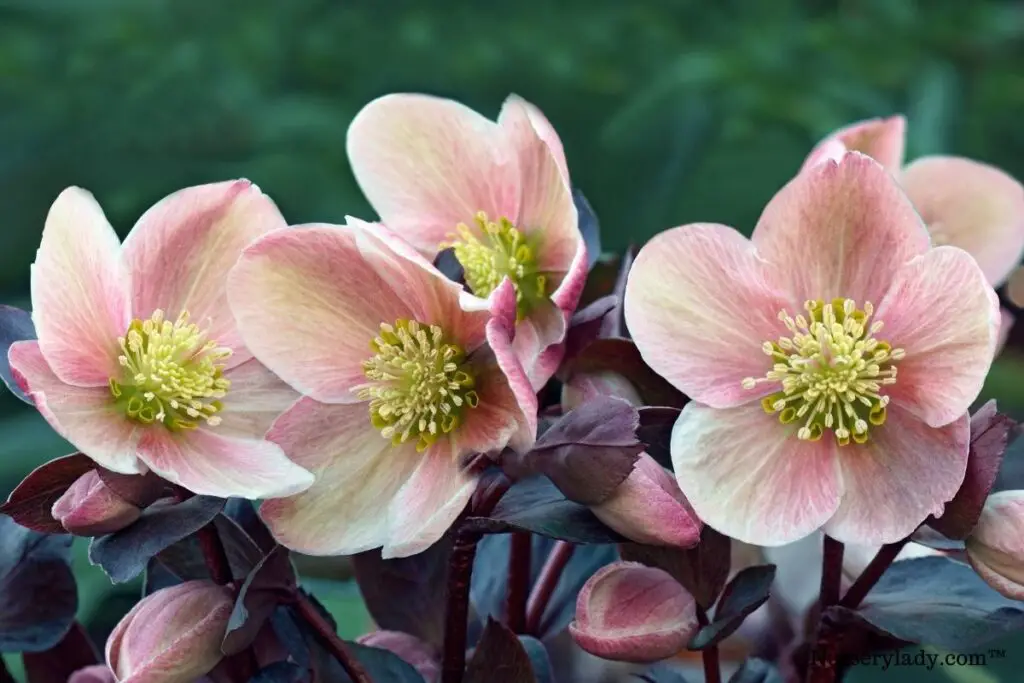
Lenten rose belongs to the buttercup family producing frilly flowers in colors like white to pink, light rose to purple, along with green foliage. They are grown for blooming in early spring, and they fade as summer approaches.
Light: Lenten rose prefers shady locations, especially in cooler months. Please keep them in bright light to partial shade in hot summers. Do not keep under full sun.
Water: Water lenten rose in regular intervals and ensures proper drainage. Never over water and check the soil before watering to avoid sogginess. Established Lenten rose can tolerate short periods of drought.
Fertilizer: Fertilize with a slow-release fertilizer in late winter to encourage new growth. Avoid over-fertilizing as it will burn the roots and affect plant growth.
General care: Lenten rose may struggle in extreme winters. Please keep them in a safe spot during winter and hot summer. Maintain average to high humidity.
Looking for gardening supplies? We have tested 100's of products before recommending them to you guys. Check out our best pick below:
| Image | Gardening Supplies | Best Price? |
|---|---|---|
 Top
Top Top
Top | Raised Garden Bed Kit | Check On Amazon |
 | XLUX Soil Moisture Meter, Plant Water Monitor, Soil Hygrometer Sensor for Gardening, Farming, Indoor and Outdoor Plants, No Batteries Required | No Results |
 Top
Top Top
Top | 82 Pcs Garden Tools Set and Extra Succulent Tools Set | Check On Amazon |
 | Joeys Garden Expandable Garden Hose with 8 Function Hose Nozzle, Lightweight Anti-Kink Flexible Garden Hoses, Extra Strength Fabric with Double Latex Core, (50 FT, Black) | No Results |
 Top
Top Top
Top | Dual Chamber Compost Tumbler | Check On Amazon |
 Top
Top Top
Top | Sunnyglade Plant Stakes | Check On Amazon |
 Top
Top Top
Top | Organic Cold Pressed Neem Seed Oil | Check On Amazon |
 Top
Top Top
Top | Mighty Mint Gallon :-Insect and Pest Control Peppermint Oil | Check On Amazon |
 Top
Top Top
Top | Scotts DiseaseEx Lawn Fungicide | Check On Amazon |
 Top
Top Top
Top | Jacks Classic 20-20-20 All Purpose Fertilizer | Check On Amazon |
 Top
Top Top
Top | 30,000 Seeds Pollinator Attracting Wildflower Mixture | Check On Amazon |
 Top
Top Top
Top | Survival Vegetable Seeds Garden Kit-Over 16,000 Seeds | Check On Amazon |
Tulip
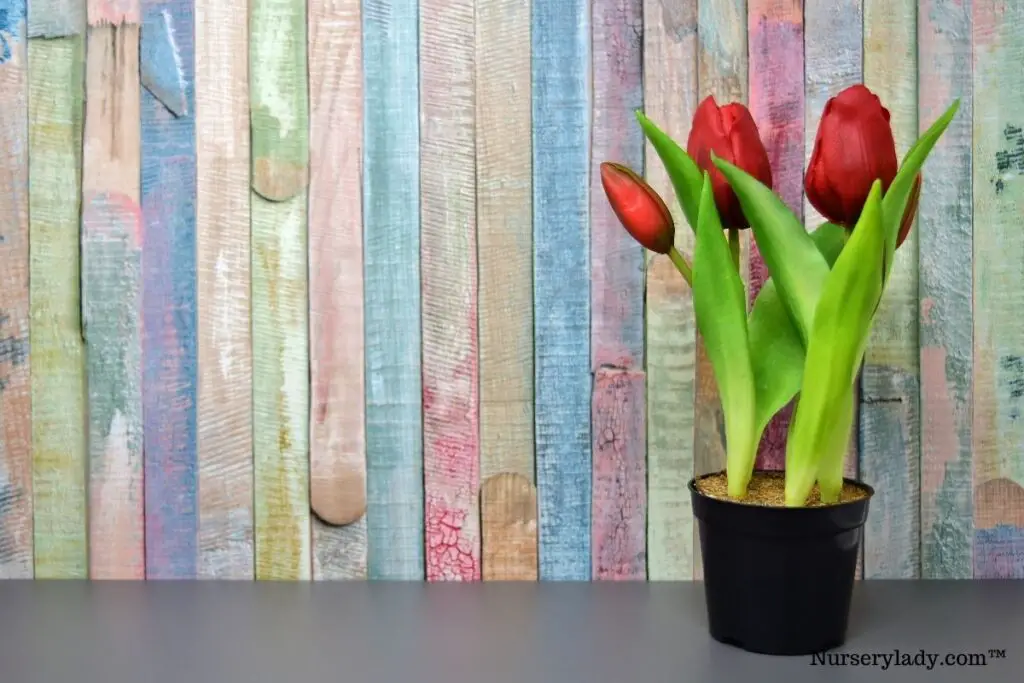
Tulips have waxy foliage and cup-shaped flowers. Different species have different shapes, forms, and colors, and they will lift your spirits by blooming in the spring.
Light: Tulips prefer full sun, no matter which variety. Finding a sunny location and direct light is best for them to bloom abundantly and stay healthy.
Watering: Tulips can withstand dry periods, but young ones need regular watering. Check the soil by digging your finger in the soil to check the soil moisture. Let the soil dry out between waterings.
Fertilizer: Feed tulip while planting with compost, granular fertilizer. Feed with a balanced fertilizer in spring once to encourage better blooming.
General care: Tulips grow in a variety of conditions. They can grow well in cold weather and dry, humid conditions, and they prefer dry regions and do not like humidity.
Columbine
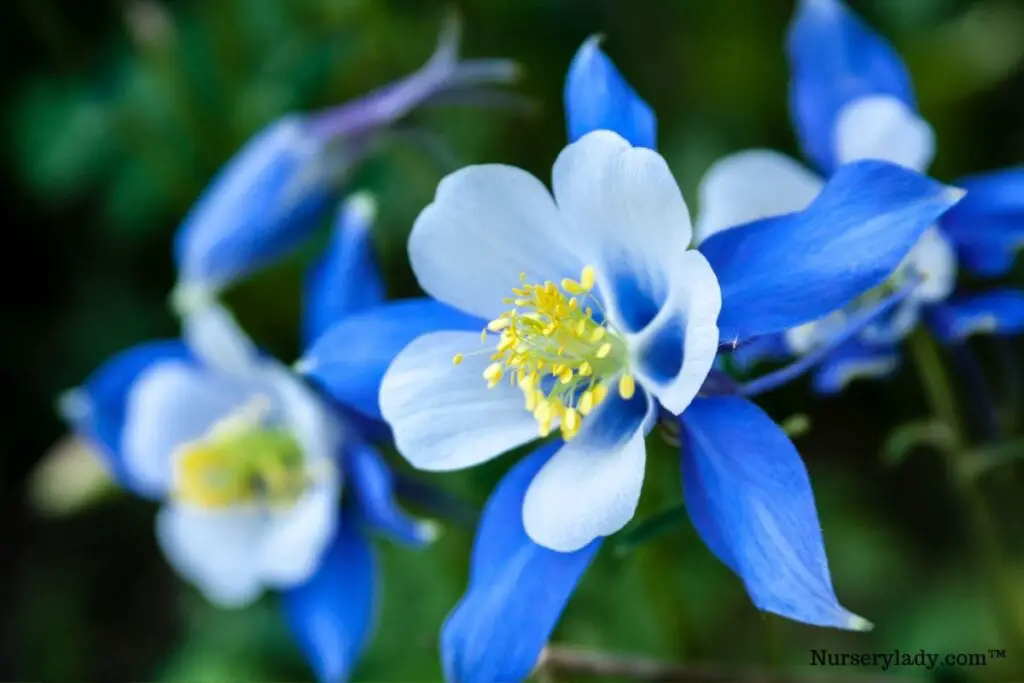
Columbine has attractive foliage and produces blooms in several colors and forms. They grow at a moderate speed and are toxic to animals, and they are perfect for containers, woodland gardens.
Light: Columbine grows best flowers in full sun and will appreciate some shade in the harsh afternoon sun. During winter, keep them in full sun for better light exposure.
Water: Water Columbine to keep the soil consistently moist but never soggy. Let the halfway soil dry and water thoroughly to allow the excess water to drain out. Add mulch to retain moisture in summer.
Fertilizer: Feed Columbine with diluted balanced fertilizer monthly once during the growing period. They prefer high phosphorus fertilizer such as 5-10-5 fertilizer for healthy growth and better blooming.
General care: Columbine likes cool temperatures. They are sensitive to high heat conditions. Please keep them in a safe spot during such conditions. During frost, keep them near radiators, fireplaces. Deadhead to avoid self-seeding.
Sweet alyssum
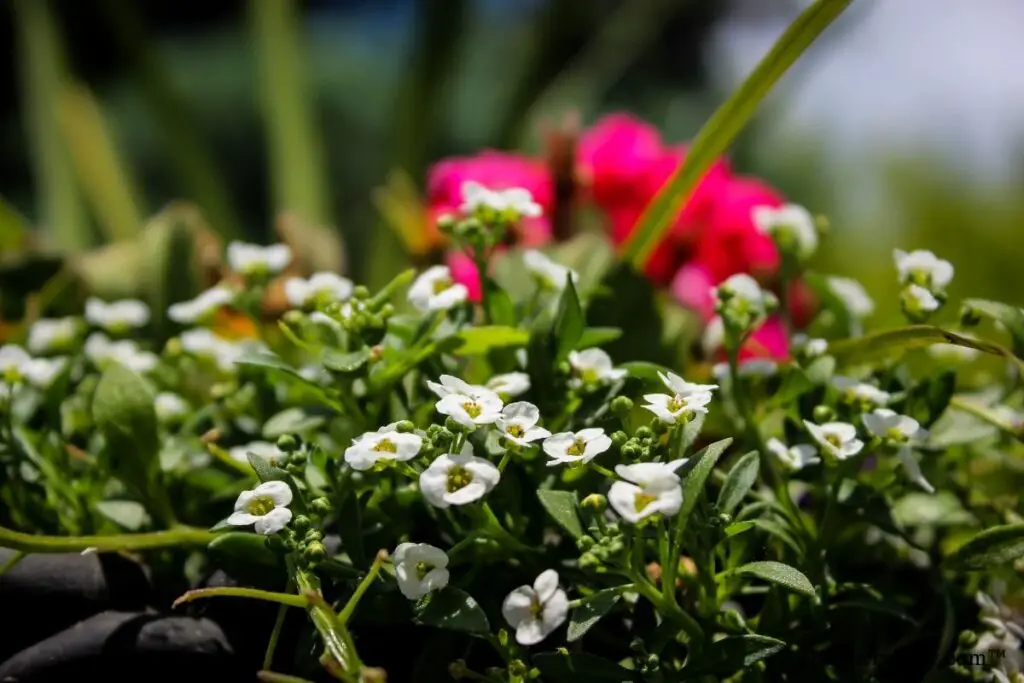
Sweet alyssum looks gorgeous as a colorful carpet of their four-petal flowers in the garden, landscape, etc. They bloom in early spring and then again in fall. They are easy-growing, fast-growing plants in most of the areas. They have a light fragrance and are easy to care for.
Light: Sweet alyssum blooms best in sunny spots. Look for the spot that receives most of the light for 6-8 hours a day. Some shade is appreciated if the sun is too strong.
Watering: Water sweet alyssum every week with a cup of water. Increase the frequency of watering in dry, hot weather. Ensure proper drainage or the plant will be affected due to root rot.
Fertilizer: Sweet alyssum are light feeders but appreciate some food if the soil is poor. If they are growing in pots, then monthly feeding in the growing months is required. Feed with organic fertilizer again after the blooms are spent.
General care: Sweet alyssum are heat-sensitive and may stop blooming in hot summer. They are fine with all humidity levels but reduce the watering frequency during high humidity.
Grape hyacinths
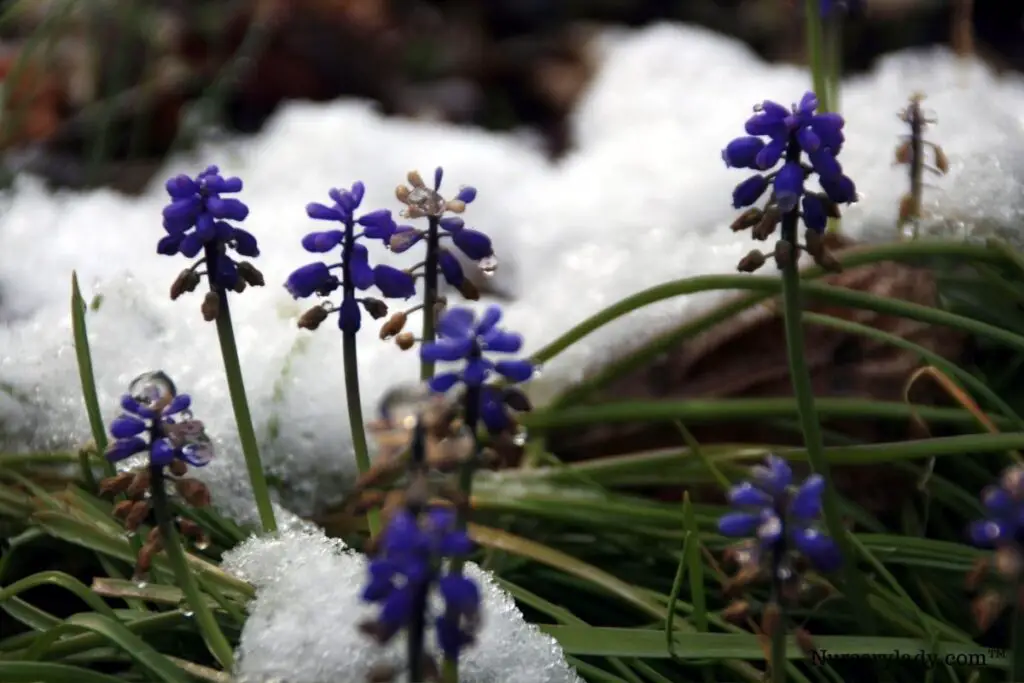
Grape hyacinths produce little flowers in clusters looking like grapes. They are purple or white, blooming every year. They add color to your garden in early spring with little care. They have grass-like leaves which nourish the plant.
Light: Grape hyacinths perform well in full sun and can grow in some shade too. The best location is where they can receive 6-8 hours of indirect or direct bright light in a day.
Watering: Grape hyacinths do well in moist soil but need it to dry out before watering. Frequent watering during summer is good but ensures proper drainage. Also, make sure that the soil is not sitting in water.
Fertilizer: Grape hyacinths do not need feeding to grow and bloom. However, adding ¼ cup bone meal/ 100 sq. Ft. of soil once in the fall is good enough for growth and blooms.
General care: Grape hyacinths need cool months to bloom. Cut off foliage when it begins to turn yellow.
Lilac
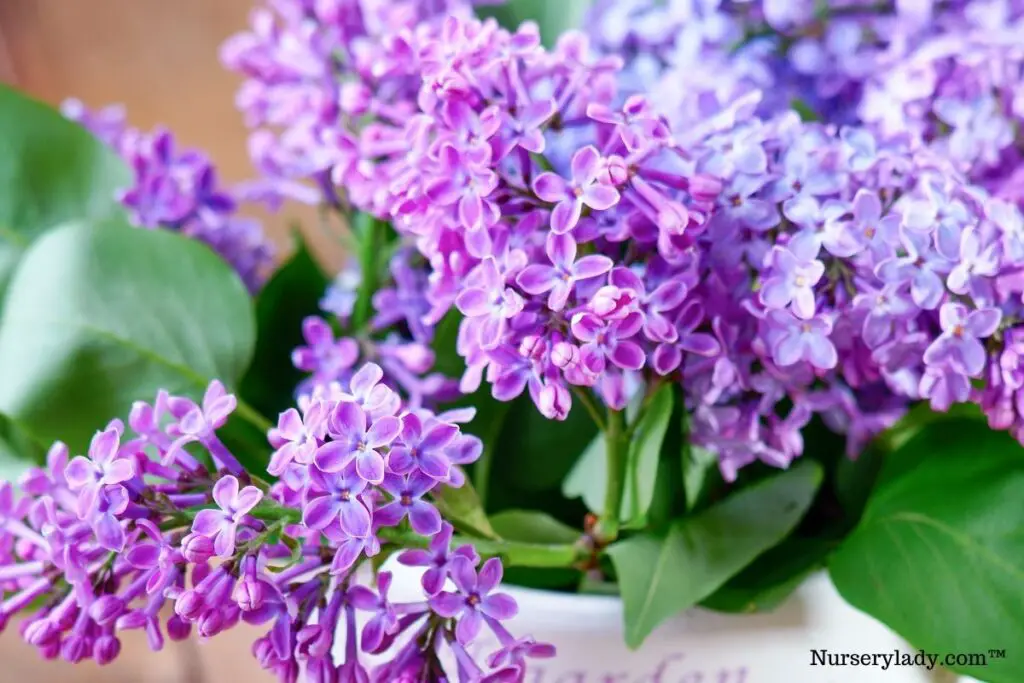
Lilac is a beautiful shrub blooming during spring. They have a sweet fragrance and appear in a bunch, and their leaves are gray-green. Lilacs grow at medium speed and reach up to 15 feet tall and 12 feet wide.
Light: Lilac should be kept in 6-8 hours of full sun to indirect light for best blooms and growth. Low light or shady locations for long periods can limit their flowering. Avoid keeping them in full shade.
Watering: Water lilacs to keep the soil moderately moist. The best way to ensure that is by checking the soil every few days and water accordingly. Mature lilacs need less watering and can grow in short periods of drought too.
Fertilizer: Lilacs are light feeders. Feed them with a balanced fertilizer in the spring. If the soil is poor, ensure feeding but never overfeed. Always dilute the suggested strength to half.
General care: Lilacs like cool temperatures. Avoid exposing them to hot, humid climates. They are easily prone to pests infestation, root rot in high humidity areas. They can withstand freezing temperatures, but some protection is appreciated to protect their buds.
Lupines
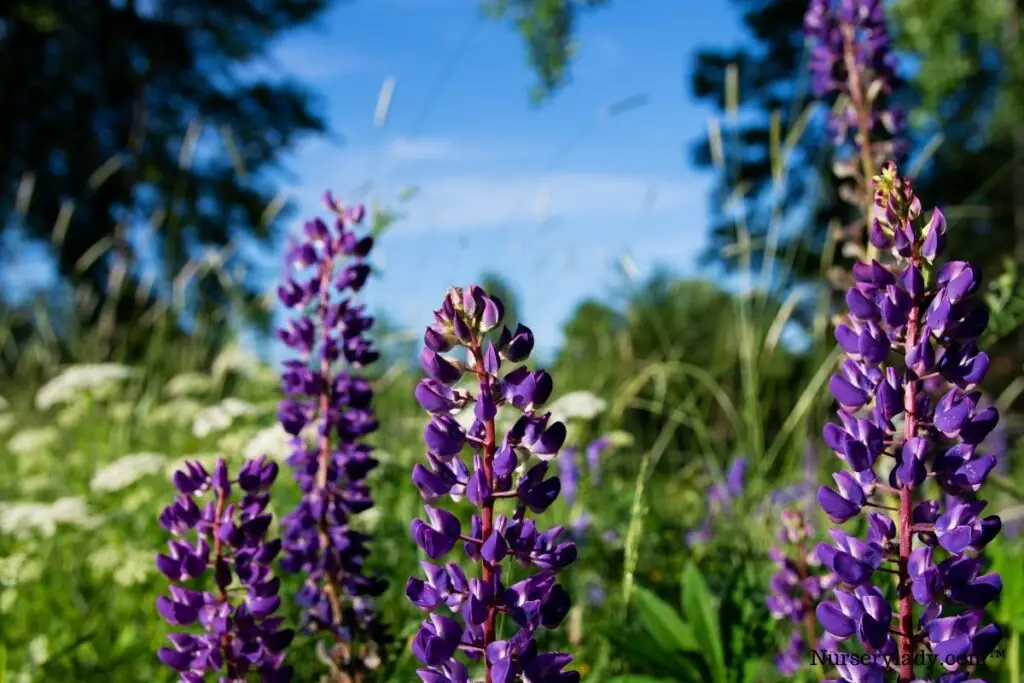
Lupines are spring blooms that add colors to your garden in spring, and they look so subtle with their spiky flowers in a mass of colors. They are fast-growing but also toxic to animals and humans, and they grow well in pots, grounds, pathways, etc.
Light: Lupines can grow from full sun to partial shade. They will look and bloom best in spots receiving 6-8 hours of indirect sunshine. During hot summer, some shade in the afternoon is appreciated. Too shady locations will limit their flowering.
Watering: Water lupins in regular intervals. Always ensure proper drainage and avoid watering when the soil is wet, and it encourages root rot, fungal problems, etc. Let the soil dry halfway before watering.
Fertilizer: Lupines are light feeders and can survive even without any feeding. You can feed them with acidic fertilizer to lower the soil pH for plants growing in alkaline soil.
General care: Lupines like cool summers and may struggle in hot, humid conditions. In hot summer, you can add a layer of mulch to retain soil moisture. Use stakes for taller varieties of lupines to prevent flopping.
Peace lilies
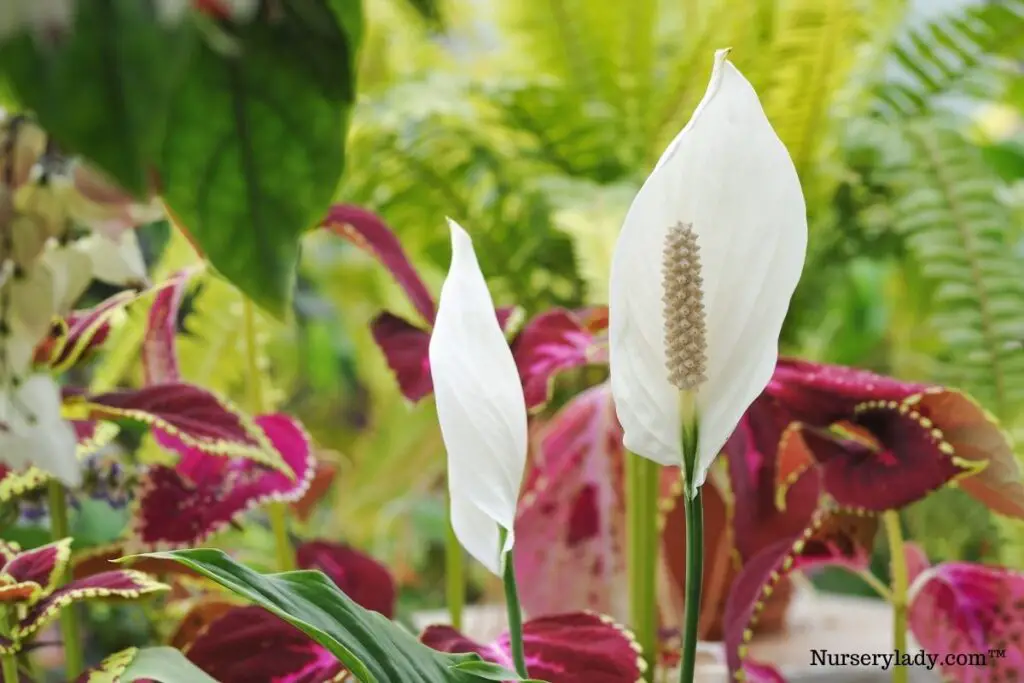
Peace lilies produce flower stalks that hover over the leaves and are long-lasting. They have shiny green leaves, and they bloom in the spring and bloom for several months. They mature in 3 years, reaching up to 6 ft height, and are toxic to pets.
Light: Peach lilies do well in the shade, but they appreciate some light indoors. They should not be exposed to direct sun, and if the leaves turn pale, it indicates direct harsh light. Please keep them in the shade for the best growth.
Watering: Peace lilies need little water to thrive, and water them only when the soil is dry. Water according to the need of the soil without letting the soil dry out completely but keeping it evenly moist.
Fertilizer: Peace lilies will be healthiest with frequent feeding in the summer. Use balanced fertilizer for monthly feeding and add a slow-release fertilizer at the start. Avoid feeding in the winter season.
General care: peace lilies like warm temperatures and may struggle in temperatures below 55 degrees Fahrenheit. The ideal temperature level for them is 65 degrees Fahrenheit and 80 degrees Fahrenheit. Please do not keep them in cold weather for long periods, or they may die.
Weigela
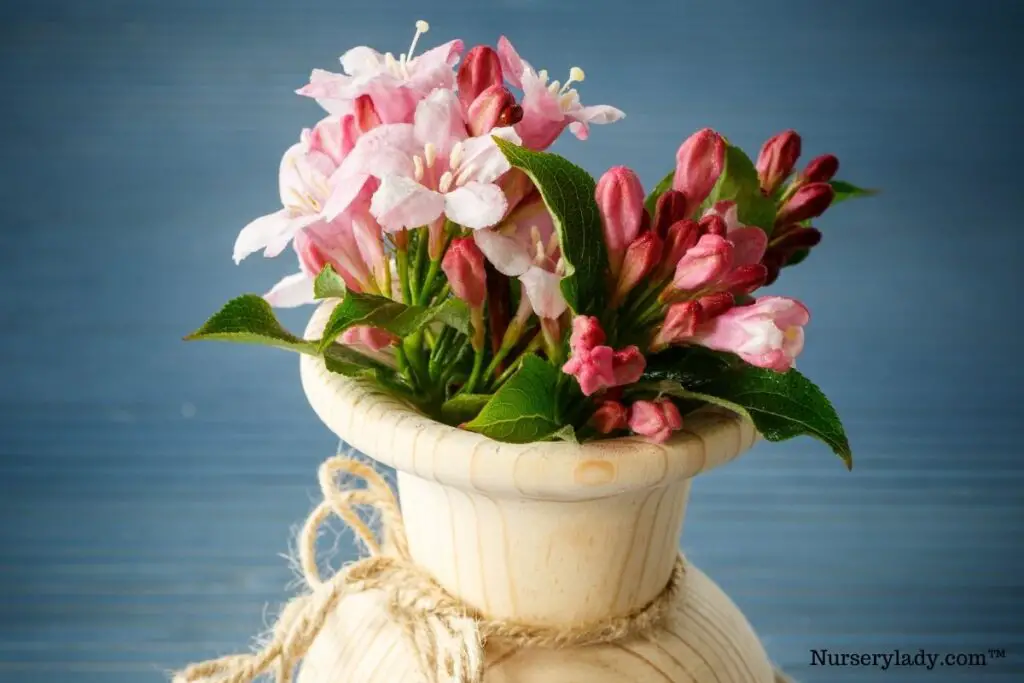
Weigela is an old-time planter’s favorite and is popular in ornamental landscaping. They are moderate growers and can reach up to 10 ft in height. They have green leaves along with petite attractive blooms. They brighten your landscape, containers during summer and spring.
Light: Weigela enjoys bright light that is direct for long hours. Keep them indirect light for 6-8 hours a day. You can keep them in partial shade on hot summer days but not in full shade. Full shade can inhibit their flowering.
Watering: Young weigela like frequent watering to establish their roots. Mature ones need very little attention for their water needs. Simply water when the soil is dry and during rainfall no need to water them.
Fertilizer: Weigela is a light feeder, and they can be fed before the new growth appears with a balanced fertilizer. Slow-release fertilizer is also a good choice to boost their flowering.
General care: Weigela will do well in all temperature levels except for extreme ones. Pruning can be bypassed if you want them to prune after it has bloomed for the season.
Forsythias
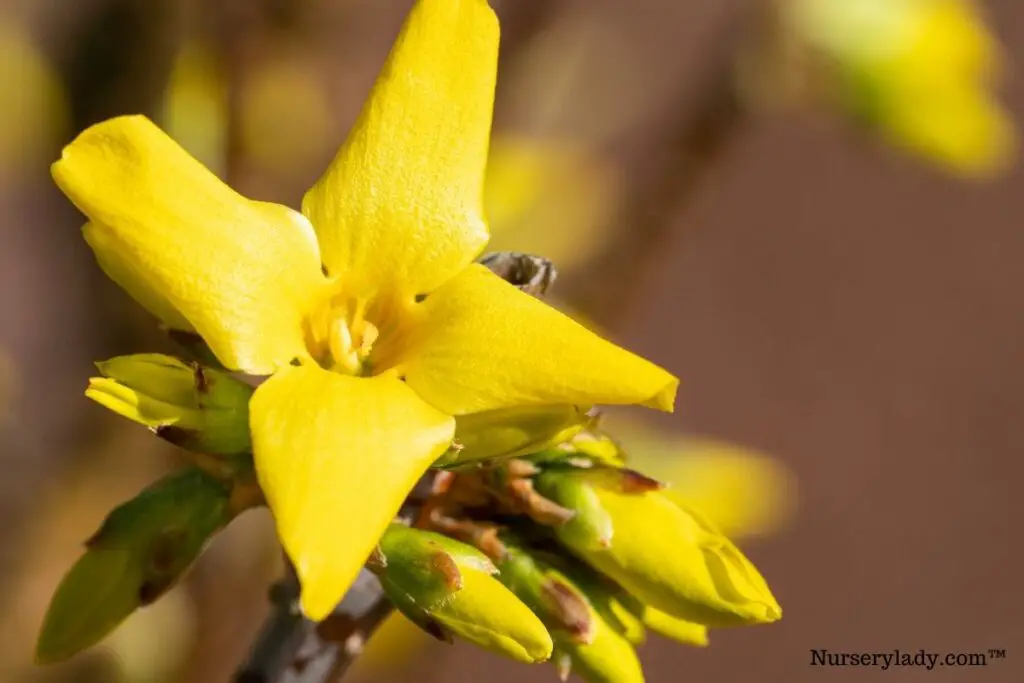
Forsythias are known for their long branches filled with cheerful yellow flowers in the early spring. They are easy to grow, fast-growing, and loved by butterflies and bees. They can reach up to 10 feet high and be trained to grow like a vine.
Light: Forsythias produces abundant flowers when it receives full light. They need 6-8 hours of direct light; otherwise, they will not be able to grow as many blooms.
Walter: Forsythias need proper watering when young, and once matured, they can do well in short periods of drought too. Check the soil moisture before watering to avoid sogginess.
Fertilizer: Feed Forsythias after a year of planting them. Add balanced fertilizer by diluting it to half the strength monthly throughout the growth period.
General care: Forsythias like humidity, and they neither like wet conditions nor too dry. The ideal temperature for Forsythias is between 55 degrees Fahrenheit to 70 degrees Fahrenheit. They are cold-hardy, but some protection will improve the chances of better blooming.
Bearded Iris
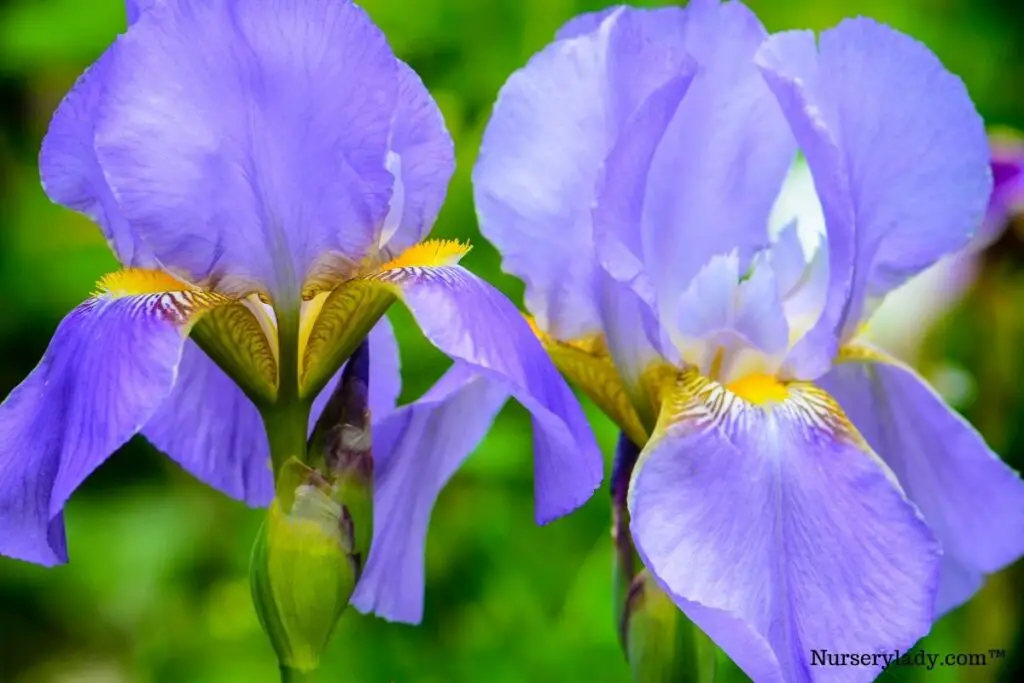
Bearded iris produces flowers in sword shape in rainbow colors beautifying your garden in the spring. They grow easily with little care.
Light: Bearded iris requires full sun exposure for better growth and blooms. In shade and low light, they will produce lesser blooms and also invite diseases. Though some shade during hot summer is appreciated.
Water: Bearded iris likes frequent watering to stay evenly moist. Check the soil by digging a finger/skewer in the soil from the top. Water only when the soil is dry, and they can tolerate short periods of dryness too.
Fertilizer: Fertilize the bearded iris with a bone meal for better blooming. You can also use low nitrogen fertilizer for feeding bearded iris once in the spring.
General care: Bearded iris can do well in extreme temperatures. They need well-draining soil to allow excess water to drain easily. Please keep them in a safer spot during harsh winter winds.
Epimedium
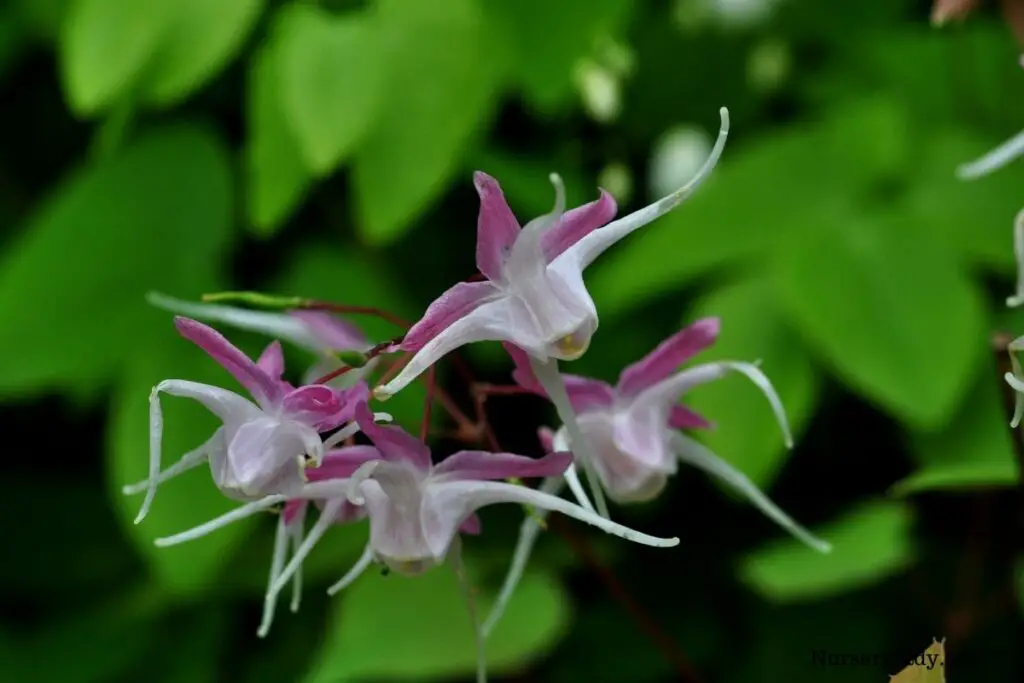
Epimedium produces beautiful blooms in the spring, adding many colors to your garden. They can grow up to 12 inches tall and 36 inches wide. They are low maintenance and are flexible.
Light: Epimedium grows best in dappled light to partial shade. They do not appreciate the full sun as it can scorch their leaves and also affect flowering.
Watering: mature Epimedium can withstand short periods of drought and does not need regular watering. They must be grown in well-draining soil to ensure proper drainage. Uniform watering is required only for young epimediums.
Fertilizer: Epimedium can do well without feeding but adding your leaf mold will encourage blooming. You can also add a slow-release in the spring once.
General care: Epimedium is a sturdy plant. They do well in warm temperatures and can handle all humidity levels. Some protection from high heat and frost is needed.
Reference: The University of Minnesota, Kansas State University, BBC Wildlife Magazine, Arizona-Sonora Desert Museum.
